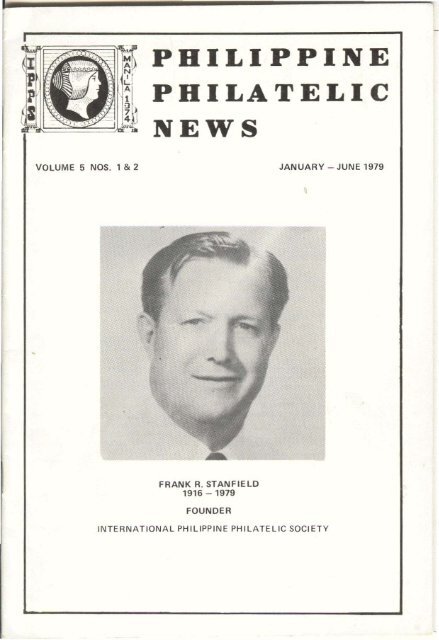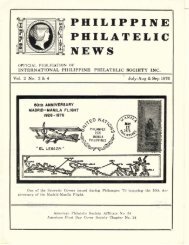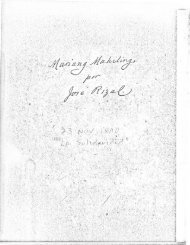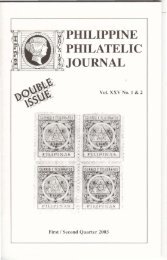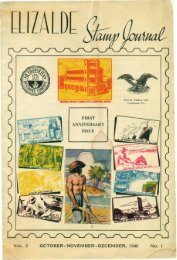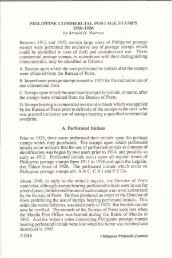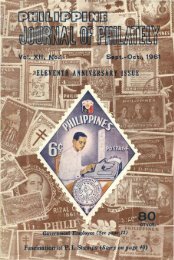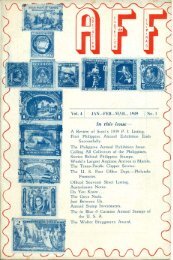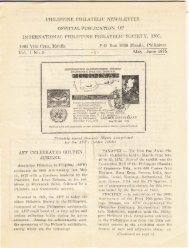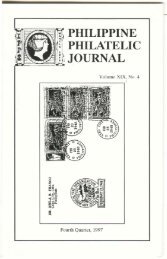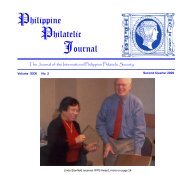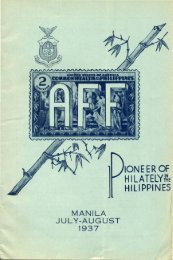June 1979 - International Philippine Philatelic Society
June 1979 - International Philippine Philatelic Society
June 1979 - International Philippine Philatelic Society
You also want an ePaper? Increase the reach of your titles
YUMPU automatically turns print PDFs into web optimized ePapers that Google loves.
PHILIPPINE PHILATELIC NEWSVOLUME 5 NOS. 1 & 2 JANUARY - JUNE <strong>1979</strong>Editor-in Chief: LINDA STANFIELDEditorial Consultants;Don Pablo EsperidionEugene A. GarrettContributing Editors:Eugene A. GarretMandy H. Labayen. Jr.Mario QueArnold H. WarrenThe <strong>Philippine</strong> <strong>Philatelic</strong> News IS publIshed quarterlyoy the <strong>International</strong> <strong>Philippine</strong> <strong>Philatelic</strong><strong>Society</strong>, P, O. Box 437, Manila. <strong>Philippine</strong>s. A non·profit. non-stock, educational organization, theIPPS was incorporated in the City of Manila onSept. 24, 1978. as per SEC registration No. 58004.Opinions expressed in \"arious articles in this pub·lication are those of the writers and are not necessarilyendorsed by the <strong>Society</strong> and/or thispublication.One year subscription to the PPN is included uponJoining the IPPS.MEMBERSHIP FEE. Regulars: Life.<strong>Philippine</strong> Residents: P35.QO annually P1,000.00Foreign Residents', US$7 .50 annually US$150.00American <strong>Philatelic</strong> <strong>Society</strong> Affiliate No. 54American First Day Cover <strong>Society</strong> Chapter No. 24CONTENTS3689182024Frank R. Stanfield 1916-<strong>1979</strong>By Linda StanfieldFrank R. Stanfield and <strong>Philippine</strong> Philately.A Love Affair.By Mandy H. Labayen, Jr.Playing Cards Tax StampsBy Arnold H. WarrenTobacco Tax StampsBy Arnold H. WarrenSummarized List of <strong>Philippine</strong> New Issuesfor 1978A Letter From A Concerned Philatelist. andthe Reply26 The <strong>Philippine</strong> Stamped Papers, Part IIBy Mario Que29Japanese Occu~)ation: "SeCret Marks" In theLaurel Issue Cachet-Cancel.By Eugene A. GarrettA Minor Philatetic MysteryBy Eugene A. GarrettOFFICERS:PresidentVice PresidentTreasurf;!rSecretaryChairman of the BoardEliezar JimenezEugene A. GarrettFe A. CarandangLinda StanfieldFrank A. Stanfield30<strong>Philippine</strong>s: An Investment PotentialBy Eugene A. GarrettDEPARTMENTS.14 New Issues23 New MembersiPublished unde: PePM Certificate of Registration No. 303Publishers AssoclatluO of the Phlllppmes. Inl".MIMBIKB.UJlD
FRANK R. STANFIELD 1916 -<strong>1979</strong>- SPECIAL PEOPLE -By Linstan'" miss my right hand and personal assistantvery much but it must be that way for sometime.The more I leave you to your own dev;ces, thesooner you do things and either learn or make mistakes.Either way. you gain knowledge that makesyou valuable ..." This was in a letter written byFrannan to Unnan in April 1968. Eleven yearslater, April 29, <strong>1979</strong> to be exact, he did finallyleave with complete confidence that his Unstanwith his three little girls could carry on.Frank spent fourteen years of his life in the USMilitary Service and was known for his "inteltigenceand complete dedication to his duties,"No wonder when he got out of the service, he had adifficult time adjusting to civilian life. Very fewunderstood him - arid his military-like attitudes.But what can you do, a hero like him, decoratedby no less than Gen. George S. Patton, Jr. He receivedno less than eleven decorations a{ld citations:Silver Star, Bronze Star Medal, Din. UnitBadge, Combat Infantry Badge, Good ConductMedal, American Defense Medal, EAME Amer·ic~n Theater, WW II Victory Medal, NetherlandOrange Lanyard, Belgian Fourragere, and AirMedal.His milnary occupation specialty was AirborneInfantry Unit Commander. He was in Europeduring WW II and was one of the eXPert pal ach ...·tists. He personally entered Germany after Hitlerfell and was one of the first ones to liberate can·centration camps and rehabilitate the Jews.Frank was also in Korea where he, once "lgain,showed his "immense capabilitie~ of organizingpeople and making sure their jobs were all donewell." He received a letter of commendation fromthe Senior Adviser, US Military Advisory Groupto the Republic of Korea, and a letter of aporet:iationfrom Lt. Gen. Park Sun Yap, Co~;nA!~dz:.Korean Army.When Frank retired in 1953, he ~h.:i:1 the rankof Major and was a Psychological \'~arfare Officerwhich conducted black, white and gray psychologicalwarfare. He recruited, organized and directedexternal and intemal intelligence nets. Hecommanded 200 officers and 20,000 Enlisted Men.After he got out of the US Army, Frankworked as Far East Sales Representative of severalUS and European firms. In no time at all he be·came Sales Manager for the Far Eest. His work requiredhim to travel constantly, from o"e country
•to another. By the time we got married, I was ableto convince him that we should settle down inone place and live a normal family life instead ofliving out of suitcases from one hotel to the next.Manila was the choice, and for twelve solid years,no couple can ask for more. We were very com·patible; we got along very well and we were blessedwith three lovely daughters: Francesca, Doralee,and Earlane. We were completely happy.Frank was not a stamp collector really. I wasthe one who was collecting, a hobby I started sincemy high school days. During one of Frank's tripsto New York, he decided to get me a completeStamp Collectors Kit from Minkus which I t:agerlystarted fitling up. But that did not last long. As 1got more involved in our business, I started to forgetmy col;ection. But I kept buying packets afterpackets and throwing them in one box with "somedayI'll get to them" attitude.Finally, Frank got fed up and decided to mountmy stamps himself on the blank pages of myMinkus album. Pretty soon he was subscribing toLinns, Western Stamp Collectors, Stamps Magazine,etc ... He even visited the <strong>Philatelic</strong> Sectionof our Bureau of Posts and eventually joined alocal club. In short, Frank got hooked. He decidedto specialize in <strong>Philippine</strong>s but unfortunately thelocal club members were more of general collectors.Very few were interested in studying Phil·ippine postal History.With a little push from his friend CI~·r1e Carriker,Frank decided to form a club for more advanced<strong>Philippine</strong> collectors. Thus, in 1974. the<strong>International</strong> <strong>Philippine</strong> <strong>Philatelic</strong> <strong>Society</strong> wasborn. Frank pledged to bankrole the society untilit was able to stand on its own. He wanted it tobe the foundation of a good, solid group promot·ing <strong>Philippine</strong> philately. Many times. local collectorscommented that if only the <strong>Philippine</strong> <strong>Philatelic</strong>News, the official journal of the IPPS, wouldpublish news about other stamps, more memberswould join. But Frank was adamant - tPP5 willbe a medium for <strong>Philippine</strong> postal history only.There are other clubs, magazines and newspapersfor general collectors but one really for <strong>Philippine</strong>philately. Thus, in spite of all the obtacles we encountered.we were able to continue the IPPSto date.Today, the IPPS is recogniZed <strong>International</strong>lyas the group to belong if you are specializing in<strong>Philippine</strong> philately, and the PPN as the last worain <strong>Philippine</strong> philately. This is one achievementFrank could be very proud of. And. as long as Iam able to, I will continue to support the IPP5in his memory.With my lost saints - I love thee with thebreath,Smiles, tears, of all my life and if Godchoose,I shall but love thee better after death...- Sonneta from the Portuguese4
, , , ,y (\ Thank ou... \...",-......."".........".........".............,.........".........."",-......"-........",-........",..........,,....~~~1~ We would like to express our \) sincerest appreciation to all ,~ our friends who remembered us ,, during our most difficult and ~\ trying times . . . . . . . . . . \~ Thank You Alii! I \, \~ - The Stanfield Girls. ~\\, \, PAID AD. \\" • ." . . ,,,..,,.·'1,., (0fIII1II""" ~.....",..... ~ ...."..... ...."..... .....,..... .....,..... ....."..-~~ -"""" ....."".- ....",-.. ......,....,
FRANK R. STANFIELD and PI-lILIPPINEPHILATELY: A LOVE AFFAIRBy Mandy H. Labayen, Jr.FRANK A. STANFIELD was a big, bulkyindi"idlJ~!. It was no wonder then that when hedove into the local philatelic pool, he did not onlymake it with a big splash but he also made bigwaves.His debut was at the local philatelic society.the only group of collectors around. mainIV amateurs.With his intense love for the hobby. Frankwas apoalded by what he S8W. And he was not oneto keep his ideas to himself.He stood up as often as he could and insistedthat local collectors should make use of catalogsmore often. That they should eschevv stockbooksand start mounting - and writing up - their collections.That they should read more. write downmore and share their thoughts and discoveries morewith fellow collectors not only here but abroad.The initial reaction was not kindly on him.Specially on those who were uncomfortable withchange, But Frank was not in for a popularitymedal, So he charged on and was even moreappalled by what he discovered.Collectors could not concult catalogs simplybecause there were to catalogs around. They couldn.:>t mount their stamps because hinges, if theywere found, were at a premium. They could notwrlte·up or reao up sil"ce reference materials werefew and far between. And if one had indeed writtena worthwhile article, the only philatelicmedium around was a mimeographed newsletterdevoted mainly to club news.;his was a set of challenges that Frank thrivedon. And ne set te work immediately. He broughtin hinges and made them available to one and allnationwide. He bought reference books, orderedcatalogs, subscribed to journals and magazinesand threw them (and his house tool open to fel·low philatel ists.This was only the start. The growth in philatelyin the <strong>Philippine</strong>s needed stimulation. And he wasup to the challenge. For those already in the hob·by, he organized the <strong>International</strong> <strong>Philippine</strong> <strong>Philatelic</strong><strong>Society</strong> as a mature medium for philatelic Filipinianafrom the very start. Today, the society'spublication is the internationally recogniZed sourceon <strong>Philippine</strong> philately.For those who were not yet collecting Philip·pine stamps, Frank decided to go into promotingthe issues of his second home. Not wanting to competewith local dealers, he went into wholesalingof packets. Before long, his company was not onlythe biggest dealer in <strong>Philippine</strong> stamps, it was alsothe biggest buyer of <strong>Philippine</strong> stamps.6The effects on the trade were felt by all. Pricesof used stamps rose to more realistic and generallybeneficial levels. Material in the market - bothfrom suppliers and at retail outlets - improvedimmensely. And he aged local dealers into form·ing a professional organization.Meanwhile, Frank was also busy organizingexhibitions of <strong>Philippine</strong> philately. He was alwaysdonating prizes, encouraging participants, givingpointers to anyone who cared to listen. In his ownparticular field of <strong>Philippine</strong> postal history, heinspired a whole group of young philatelists toenter into this most serious fjeld.<strong>Philippine</strong> philately has not been the same sincefrank Stanfield arrived. When he closed his albumson April 29, <strong>1979</strong>, and passed on, he left a livinglegacy that affects us all and aU future generationsof Filipino philatelists. Frank is survived by hiswife, Linda, who is just as enthusiastic and equallycapable of improving <strong>Philippine</strong> philately. Theyhave three little girlS and a houseful of memora·bilia.As long as <strong>Philippine</strong> philately grows in maturity,the spirit of Frank R. Stanfield will liveon with us,
I authorize William J. Oliver to give permissionfor reprinting any philatelic articles authoredby Arnold H. Warren.Our sincerest appreciation to member BilL OLIVER for giving us the privilege ofpublishing the late Arnold H. Warren', variou, research on <strong>Philippine</strong> philatelv andretated subjects.In line with this, we are starting with this issue. the publication of Warren's studiesparticularly on <strong>Philippine</strong> Revenue. In the following pages you will find the fim of aseries of articles by Amold H. Warren. We will call this particular pOrtion of our publication''TheArnold H. Warren Studies,"7
THE ARNOLD H WARREN STUDIESPLAYING CARDS TAX STAMPSBy Arnold H. WarrenFig. 105The use of revenue stamps as the means of collectingthe specific tax on playing cards was begunin November 1919, bV the promulgation of AdministrativeOrder No. 58 of the Collector of InternalRevenue. At that time the specific tax on playingcards was 30 centavos on each "ordinary" packcontaining not more than 58. cards, with a proportionalincrease in the tax for each card in excess of58 which the pack contained. On Dec. 1, 1925,Act No. 3246 increased the specific tax on playingcards to one peso for each pack of not more than58 cards with a proportional increase for each cardin excess of 58.In November 1919. a 30-centsvos Playing Cardstrip stamp was issued. but the writer has neverseen a specimen of this stamp and hence cannotdescribe it. Section 10 of Administrative Order No.58 reads, in part: "The strip stamps shall be firmlyaffixed to the middle of the pack running lengthwiseand covering the two overlapping ends of thewrapper...."Section 16 of Act No. 2835, approved Marcha, 1919, provided that:"Any person who gives wway or accepts fromanother, or who sells, buYs, or uses anycontainer on which the stamps are not utterlydestroyed shall for each offence be finedin a sum of not less than twenty pesos normore than three hundred pesos, or by imprisonmentfor a term not exceeding sevenmonths, or both."This provision of the law has operated to practicallyprohibit the collection of used specimensof playing cards and tobacco tax stamps. There isno penalty, however, attached to collecting unusedspecimens of these stamps. But because of thealmost total lack of interest, until recently, on thepart of collectors in those stamps, it is probablythat not even one specimen of some of them hasbeen preserved.1919 (November). No description of this stampis available and the writer has never seen a specimen.It was probably about 10 mm x 20 mm, rouletted,and printed in black on blue or green paper,unwatermarked. It was probably inscribed: TAXPAID STAMP - ORDINARY PACK - PLAYINGCARDS - VALUE PO.30.W-951 301 black on blue (1 1paper.1925 (December). 203 mm x 20 mm. Rouletted.Watermarked double-lined P IRS. Typographedin black or blue on which is printed on ornamentaldesign in violet which features a monogramSIR (Bureau of Internal Revenuel within acircle. The stamps are printed in duplicate and arerouletted horizontally through the center. Theupper half is marked ORIGINAL and the lowerhalf is marked DUPLICATE. The two halves areseparated and affixed to the pack at right angleto each other. (Figure 1051W·953 Ip black .,d violet on blue piper.NOTE: It is possible and even probable. that inDecember 1925, the 30s playing cards stamps of1919 (W-951) was surcharged with a new value.P1.00. for provisional use until a new is:;ue withthe P1.00 value could be printed. If such was thecase, No. W.g53 was not issued until sometimesubsequent to December 1925. perhaps in 1926.1939 (July 1). Playing-eard Tax Stamp of 1925surcharged in red on both Original and Duplicatehalves of the stamp. "COMMONWEALTH ACTNO. 466 - Value, PO.35." Two red bars. eachabout 2 mm wide and very close together. areprinted over the original "Value, P1.00."W-954 35c on Ip black and violet on blue paper.8
TOBACCO TAX STAMPSBy Arnold H. Warren::ipecific taxes on the manufactured productsof tobacco have been imposed since August 1,1904. From August 1, 1904 to December 31,1904. the specific tax was collected in cash. FromJanuary 1, 1905. to August 31, 1914, the specificwe was collected by affixing "split" INTERNALREVENUE stamps to an Official Invoice in themwmer described in the chapter devoted toInternal Revenue Stamps. Since September 1,1914, the specific tax has been collected byaffixing tobac:co tax stamps, known as INTERNALREVENUE STRIP STAMPS, to the originalpackages of manufactured products of tobacco.Four dasses of tobaCc:o tax stalTJPs are provided Cigar Stamps, Cigarene Stamps, Smoking TobaccoStamps, lWld Olewing Tobacco Stamps.Sac:tton 16 of Act No. 2835, approved March 8.1919, and similar provisions of other Acts whichhave succ:eeded Act No. 2835 in effect, providedthat:featured a monogram, BIR, within a circle; Armsof the <strong>Philippine</strong> Islands in the center; aCAUTION, printed in both English and Spanish.at the left; at the right, labels indicating thenumber of cigars per box, the tax rate per M, andthe value of the stamp; inscribed PHILIPPINEISLANDS INTERNAL REVENUE; serial numberhandstamped in black.CatalogueNos.W-'OO,W-'OO2W-,0O3W-'OO4W-l005W-'OO6W-,007Denomination, color. etc...(al Tax: P2 per MPO.02 black and green on blue {1010.04 black and green on blue (2010.10 black and green on blue (50)0.20 black and green on blue (10010.40 black and green on blue (20010.50 black and green on blue (250)1.00 black and green on blue (500)"Any person who gives away or accepts fromanother, or who sells, buys, or uses any containeron which the stamps are not utterlydestroyed shall for each offense be fined orimprisoned, or both".While this provision of law does not specificallyprohibit the preselVation of used specimens of thestamps which have been removed from the con·tainer, it has, nevertheleS$, been deterrent to thecollection of used tobacco tax stamps. There is nopenalty attached to the collection of unused speci·mens of these stamps. But because of the almostlack of interest, untit recently. on the part ofcollectors, it is probable that no specimens of mostof the tobacco tax stamps issued prior to 1932have been preserved.W-l00aW-'009W-'010W-'O,lW-l0'2W-,013W-,014W-'015W-'016W-'017w-,o,afbi Tax: P4 per MPO.02 black and green on blue (510.04 black and green on blue (10)0.10 black and green on blue (25)0.20 black and green on blue (50)0,40 black and green on blue (100)leI Tax: P6perMPO.03 black and green on blue (5)0.06 black and green on blue (10)0.12 black and green on blue (20)0.15 black and green on blue (25)0.30 black and green on blue (50)0.60 black and green on blue (100)C IG A R S,1914 (Se~m_ 1). No specimen of this issuehave been seen, but the denor'!linations listed belowwere prescribed by Circular Letter No. 460 of theCollector of Intemal Revenue. dated August 1.1914. The following is probably accurate descriptionof these stamps: 102 mm x 30 mm; rouletted;unwatermarked. watermarked double-lined P IRS.or watermarked double-lined P I B I R; typo·graphed in black on blue paper on which wasprinted in green an ornamental background which1915 IJanuary 1). Cigar stamps of 1914 surchargedwith new tax rates and new values handwritten inred ink. No specimen of this issue have been seen.but the denominations listed below were author·ized by Circular Letter No. 472 of the Collectorof Internal Revenue, dated December 24, 1914.Whether Nos. W·l026 to W·l030 ......ere actuallyissued or not is uncertain. since class (c) stamps ofthe issue of 1914 wereavailable in the same denominationswithout surcharge.9
,... if!llFig. 107ta) Tax: P6 on P2 per M(b) Tax: P6 on P4 per MW·l019W·l020W·l021W·l022W·l023W·l024W·l025PO.06 on PO.02 black and green on blue (1010.12 on 0.04 black and green on blue (20)0.30 on 0.10 black and green on !:>fue (50)0.60 on 0.20 black and green on blue (10011.20 on 0.40 black and green on blue (20011.50 on 0.50 ~8Ck and green on blue (25013.00 on 1.00 black and green on blue (500)W·l038W·l039W·l040W·l041W·l042PO.03 on PO.02 black and green on blue (5)0.06 on 0.04 black and green on blue (1010.15 on 0.10 black and green on blue (2510.30 on 0.20 black and green on blue (5010.60 on 0.40 black and green on blue (1001W·l026W·l027W·l028W·l029W·l030(bl Tax: P6 on P4 per M1915. CIgar Stamps of 1914 hanostamped in redwith new tax rates and new values. No specimen ofthis issue have been seen, but the denominationslisted below were authorized by Circular LetterNo. 472 of the Collector of Internal Revenuedated December 24,1914. Nos. W-l031 to W-1037became obsolete and were withdrawn from cir·culation on January 1, 1916.W·l031W·l032W·l033W·l034W·l035W·l036W·l037PO.OJ on PO.02 black and green on blue0.06 on 0.04 black and green on blue0.15 on 0.10 black and green on blue0.30 on 0.20 black and green on blue0.60 on 0.40 black and green on blue(a)Tax: P6 on P2 per MPO.06 on PO.02 black and green on blue0.12 on 0.04 black and green on blue0.30 on 0.10 black and green on blue0.60 on 0.20 black and green on blue1.20 on 0.40 black and green 01'" blue1.50 on 0.50 black and green on blue3.00 on 1,00 black and green on blue151110)125)150)110011101120)(50)1100)1200}{250}150011925-1932 (71. 102 mm x 30 mm. Rouletted. Un·watermarked; watermarked double-lined P IRS;or watermarked double-lined P I B I R. Typo·graphed in black on blue paper on which is printedin green an ornamental background which featuresa monogram, BIR, within a circle. Arms of the<strong>Philippine</strong> Islands in the center; a CAUTION,printed in English only, at the left; at the right,labels indicating the number of cigars per box, thetax rate per M, and the \lalue of the stamp. in·scribed PHILIPPINE ISLANDS INTERNALREVENUE. Serial number handstamped in black.(Figure 107)W·l043W·1Q44W-l045W·l046W·l047W·l048W·l049W·l050(a) Tax: P2 per MPO.02 black and green on blue (1010.04 black and green on blue (20)0.05 black and green on blue (25)0.10 black and green on blue (50)0.20 black and green on blue (100)0040 black and green on blue {20010.50 black and green on blue (25011.00 black and green on blue (500)Note: No specimen of Nos. W-l043 to W·1050without surcharge have been seen. But Nos.W-1Q44, W-l048. W·l049 and W-l050 bearing thered surcharges affixed in the 1932 are still currentin 1941.10
tAHraLAT10ttCAU f10ijhO conte,,,TAX PAID STAMP_Ie ha~ 1l~~1:lP1W as bli'!bY~Ius of t~t;ipiJl¥if'I.nds. ~$ JIIwiCJT¥tbe brC*en UpOn
Fig. 110,1933·1935. 102 mm x 30 mm. Rouletted. Watermarkeddouble-lined P I A S. Type of 1925-1932.(F;guro 1091la) Tax: P2,30 per MW·10Sl PO.023 black and green on blue {101W-l082 0.0675 black and green on blue (25)1936-1938. 102 mm x 30 mm. Rouletted. Watermarkeddouble-lined P I A S. Type of 1925·1932.but inscribed COMMONWEALTH OF THE PHIL·IPPINES INTERNAL REVENUE. Arms of theCommonwealth in the center. (Figure 110)W·l084W-l085(.) Tax: P2.30perMPO.115 black and green on blue (SOl0.23 black and green on blue (1001lb) Tax: P4.60 per MW-l083 PO.23 black and green on blue (50)W·l086(bl Tax: P7 per MPO.175 black and geen on blue (25).Size:One Full PageOne Half PageOne Fourth PageBack CoverInside Back CoverInside Front Cover• Black and White Only.ADVERTISING RATESPHILIPPINE PHILATELIC NEWSusa,$30_00$18.00$13.50$100.00$ 60.00$ 80.00Phil. Pesos.P220.OOP130.OOP 98.00P730.00P438.OOP585.00
,~~~~~~~~~~~~~~n~n~»~n~~nn~~nnnn~nnnnn"n"~nNnn~nnnnnnnnnnnnnn~n••• •~ ~y~~ ~Po 5410 GI!ORGIA STREET ?::t~ • MI!RRILLVILLE. INDIANA 484'0 •?::t~ 2UI-e81-1829 g)2 MEMBER A50'" 'I:f• •~ IF YOU COLLECT PHILIPPINES, OR U.S. POSSESSIONS gYOU O'tlE IT TO YOURSELF TO BE RECIEVING OUR PRIVATE TREATY SALES. • •: These ~llustrated sales are sent to you free for gthe asking. • •• DISPOSING OF YOUR COLLECTION? IF IT CONTAINS •~ PHILIPPINES OR U.S. POSSESSIONS YOU SHOULD CONTACT US. g~ WE WILL BE INTERESTED IN EITHER BUYING IT OUTRIGHT OR g.~ IN SELLING IT FOR YOU IN OUR PRIV~TE TREATY SALES. g• ~ •~ Since we speciaiize and know the value of your u~ material, we offer more for it. If you should decide to g~ place your material with us for sale, our mailing list ~r.;: of over 1,600 people interested in Philippiries, or U.S. 'z:(• •~ Possessions ~orld wide, offers you an extensive specialist ?::t: market. gr.;: Please contact us for further information on our ?::t)2 commission rates. We are particularly interested 1n better ~• ~ <strong>Philippine</strong> material, and speciality items such as revenues ~ •: Commercial Overprints, Perfins and early covers. We are ~~ actively seeking the 1925 and 1931 Imperforate Issues of ~J::i. the <strong>Philippine</strong>s on cover.. ?:1· U• •.~ MAY WE SERVE YOU? ;~, ~ SP£CIALIZING IN U S POSSESSIONS a PHILIPPINES ALL ERA S ~k Mr ..a .... "'SOA APS SPA ,PPS PPS PPSA ClSG USPSG WWC PC CASOA '>;f· ~• • •~&.i WE ARE NOW ACCEPTING ?'l; PAYMENTS IN PHILIPPINE PESOS. ;-" INQUIRE FOR MORE DETAILS. l::Ia• •J::tt:...::{ Il.u >.1 ...U~:J.t ~o:s: J,::f .I'::llol,.Ii ••ct{J.:tlo:ll.1 U J..' ...03, J,::f J,::f J,), .\.1.:u:t.l.1.u.L.u >:O::O:{J.:t J.::{ £(j.:{.1.1 J.::{tl:.:1l.1)J >::11.1 >:O::O:S.I.1)oJ ~.-.11.! l.1l.1 J,L: _\ -.;13
nEW ISSUESGEN. CARLOS P. ROMULO - issued Jan. 14.<strong>1979</strong> I,' 30$ and P2.00 denominations with onemillion copies each. The stamp measures 27 x 37mm.• in sheets of 50. Printed by Apo/Neda. Manila,in 4 colors by off-set litho. One thousand setsware overprinted "SPECIMEN". Issued on theoccassion of Gen. Carlos P. Romulo's BOth birthanniversary. Gen. Romula began his public servicewhen he served as a young aide of the late Pres.Manuel L. Quezon. During WIN II. he served asGen. Douglas MacArthur's aide.-de-eamp in Bataanand Corregidor. He accompanied Gen. MacArthur'sliberating forces in the famous Leyte Landing.After the war, he contributed to the founding ofthe United Nations and later was elected presidentof the UN General Assembly and twice presidentof the Security Council, the first Asian to holdsuch pOsitions. FOCs were serviced at the ManilaPost Office.MANILA ROTARY CLUB - issed on January 26,<strong>1979</strong>, in 30s and P2.30 denominations with onemillion copies each. The stamp measures 27 x 37mm., in sheets of 50. Printed by Apo/Neda, Manilaby offset-litho in 4 colors. One thousand sets wereoverprinted "SPECIMEN". Issued to mark the60th Anniversary of the Manila Rotary Club. FOCswere serviced at Manila Post Office.wC)'"ROSA SEVILLA DE ALVERO - ISSUed on March4. <strong>1979</strong> in 30s denomination with 30 millioncopies. The stamp measures 19 x 30 mm., in sheetsof 100. Printed by Apo/Neda, Manila by offsetlithoin one color. One thousand sets were overprinted"SPECIMEN". Issued to commemorate thebirth centenary of Rosa Sevilla de Alvero, founderand first President of the Instituto de Mujeres. Avery 'Nell known educator and writer, she alsocampaigned actively for the grant of suffrage toFilipino women. FOes were serviced at the ManilaPost Office.14SPECIMEN
NIDO Oil COMPLEX - issued on March 21, <strong>1979</strong>in 30s and 45s denominations with onlv 500,000copies each. The stamp measures 27 x 37 mm., insheets of 50. Printed by Apo/Neda, Manila, byoffset-litho in 4 colors. One thousand sets wereoverprinted "SPECIMEN". Issued in honor of theNido Oil complex, located in the NorthwestPalawan Shelf some 27 miles offshore northwest ofthe nearest island of Palawan province. In 1976,the Nido 1 discovered oil northwestern Palawan,and subsequent drillings made in 1977 resulted inthe discovery of 3 more oil wells namely: SouthNido 1, West Nido 1 (where commercial quantitiesof oil are being tested), and Cadlao 1. FOCs wereserviced at Manila Post Office.,.AS 30PlbH'IN-RS-PILIPIN-R SPlblPINofHiBIROS - issued on April 16, <strong>1979</strong> in the followingdenominations and quantities:30.P1.20P2.20P2.30P5.00P5.00Merril's Fruit DOlle (Puna ... IBrown Tit-Babbler (Parleros)Mindoro Imperial PigeonIBalud). Steere's Petta (Llako}- Koch's Pitta (Liako)- Phil Eared Nightjar(Kandarapal600,000500,000, 300,000300,00050,00060,000The stamp measures 29 x 47 mm., in sheets of 40.One thousand sets vvere overprinted "SPECIMEN",Printed by House of Questa, Ltd., London, Englandby Fine Screen lithography, In 4 colors. Aside fromthe above quoted quantities, 550,000 sets wereissued in CTO (Cancelled To Order! forms. FOeswere serviced at Manila Post Office.15
ASSOCIATION Of SPECIAL LIBRARIES issued on April 30, <strong>1979</strong> in the following denominationsand quantities: 30$ - 5 million; 100 - 2million; and Pl.OO - 2 million. The stamp mea·sures 27 x 37mm., in sheets of SO. Printed by ApolNeda, Manila by offset-litho in 4 colors. Onethousand sets were overprinted "SPECIMEN".Issued to mark the 25th Anniversary of the Associationof Special Libraries of the <strong>Philippine</strong>s.FDCs were serviced at Manila Post Office.PllPINASASSOCIATlON OF SPECiAL LI8RAA&ES)UNCTAD V CONFERENCE - issued on May 3,<strong>1979</strong> in Pl.20 and P2.30 denominations with 2million copies each. The stamp measures 27 x 37mm., in sheets of SO. Printed by Apo/Neda,Manila, by offset-litho in 4 colors. One thousandsets were overprinted "SPECIMEN". Issued tomark the opening of the Fifth Session of theUnited Nations Conlerence on Trade and Development(Unctad VI which was held in Manila fromMay 3 to <strong>June</strong> 1, <strong>1979</strong>. FDCs were serviced atManila Post Office.PlllH'INflii'1~Choflg9 0 ~Macc.~a phitippinensis phIlipp nensj(tGeoflrey)PllllPINflS)ANIMALS - issu'Jd on May 14, <strong>1979</strong> In thefollowing denomini tions and quantities:30,Pl.20P2.20P2.30P5.00P5.00. Musang- Chonggo- Saboy Damo- Maral- Dinggin- Malintong· 600.000· 500,000· 300,000· 300.00050,00050,00016I MatintongParamanis tulianensis (Elera)The stamp measures 29 by 47 mm., in she-ets of40. One thousand sets were overprinted "~PECIMEN". Printed by House of Questa, Ltd., London,England, by Fine Screen lithography in 4 colors.Aside from the above quoted quantities, 5SO,000sets were issued in CTO forms. F DCs were servicedat Manila Post Office.
WORLD TELECOMMUNICATION DAY - issuedon May 17, <strong>1979</strong> in the following denominationsand quantities: 90s - 3 million; P1.30 - 1 million.The stamp measures 27 x 37 mm., in sheets of 50.Printed by Apo/Neda, Manila, by offset-litho in 4colors. One thousand sets were overprinted"SPECIMEN". Issued to mark the 11th WorldTelecommunication day sponsored by the <strong>International</strong>Telecommunication Union, with thetheme "Telecommunication for All". FDCs wereserviced at Manila Post Office.WORLDDAYiPILIPINASPILIPINAS".20Mus~ndaOo~ auraMUSSAENOAS IFLOWERS) - ISSUed on <strong>June</strong> 11.<strong>1979</strong> In the following denominations and quantities:30,P1.20P2.20P2.30PS.OOPS.OODona EvangellnaDona EsperanzaDona HilariaDona AuroraDona Trining- Gming Imelda600,000500,000300,000300,00050,00050,000The stamp measures 29 x 47 mm.. in sheets of 40.One thousand sets were overpnnted "SPECIMEN".Printed by House of Questa Ltd.• London, Englandby Fine Screen Lithography in 4 colors. ASidefrom the above quaoted quantities, 550.000 setswere issued to eTO forms. Gining Imelda wasnamed after our present First Lady. Mrs. ImeldaR. Marcos, while the rest were named after formerFirst Ladies of the <strong>Philippine</strong>s, namely: Mrs.Evangelina Macapagal. Mrs. Esperanza Osmena,Mrs. Hilaria AgUInaldo. Mrs. Aurora Quezon. andMrs. TriOldad de Leon Roxas. F DCs were servicedat the Manila PoSt Office.ERRATUM:PPN, Volume 4 Nos. 3 and 4, July-Gee. 1978 issue, page 21; should reild as follows:FISHES ....."The stamp measures 29 x 47 mm.• In sheets of 40."
SUMMARIZED LIST OF PHILIPPINE NEW ISSUES FOR 1978Date of 1.....8: Denorninations: Quantity: Specimens: eTC:F.. EMtem University:January 26 305 1 millionSip.: A Filipino Game:February 28 5s, lOs. 40s, 755(Setenant block)5 million eachGregoria de Jesus:March 28 1.20 SmillionJose Rizal:April 11 305 SmilllonMeyc...yan Quadricentennial:April 21 1.05 3 millionLope K. Santos:April 26 90, 5 millionCapex '78:<strong>June</strong> 9 2.50.5.00(setenant)50,000 eachP30.00 SouvenirSheets (4 pes. ofP7.50 stamps)Perforate 15.000Imperforate 15.000Cod_ of Kalantlaw:<strong>June</strong> 19 305 10 millionBonifacio Monument:July 10 30, 20 millionWorld Chess Championship:July 17 305.2.00 1 mill jon eachBenguet Consolidated:August 12 2.30 1 millionQuezon Centenary:August 19 305. 1.00 1 million each 1.000<strong>International</strong> Law Association:August 27 2.30 1 millionOsmena Centenary:September 8 305, 1.00 1 million each 1.000<strong>Philippine</strong>-Singapore Cable:September 30 1.40 1 millionWorld Basketbell Championship:October 1 305.2.30 1 million each 1.000San Lazaro Hospital:October 13 50, 3 million 1.00090s 5 million 1.000Smallpox Eradication:October 24 30, 5 million 1.0001.50 1 million 1.00018
1978 <strong>Philatelic</strong> Week:November 23 50. 2 millionDee.de of Filipino Child:November 28 305 5 million1.35 1 millionPhillppme Long Distance Telephone Co.November 28 305,2.00(Setenant) 500,000 each 1,000AIIOO Quldri~mnnlat:December 7 305 5 million 1,000• 450 2 million 1,000Batayan Quldricentenniat:December 8 305 5 million 1,00090s 2 million 1,000Human Rights:December 10 305 5 million 1,0003.00 1 million 1,000Or. Honoria Sison:December 15 305 5 millionFishes:December 29 305 600,000 1,000 550,0001.20 500,000 1,000 550,0002.20 300,000 1,000 550,0002.30 300,000 1,000 550,0005.00 50,000 1,000 550,0005.00 500,000 1,000 550,000SECOND FLOORMANILA HILTON HOTELU.N. AVENUE, MANILAP.O. BOX 1936MANILA, PHILIPPINESTEL. NOS: 58-314B59·52·5159-36-88MS. LINDA STANFIELDTHE COMPLETE STAMP SHOPIS
ALETTER FROM A CONCERNED PHILATELiST••••Gen. Felizardo A. TanabeActing Postmaster GeneralDear Sir:May 23. <strong>1979</strong>I have this opportunitY to greet you again. I met you and your wife in San Franciscoin 1975 at the luncheon for the 50th Anniversary of Pan Am's historic flight to the <strong>Philippine</strong>s.I was also in the <strong>Philippine</strong>s in 1977 to help judge the "Aeropex '77" stamp exhibitionat the Thomes Jefferson Culturel Center. I had the opportunity to visit with Mr. Pedro GambaIan on 8 number of occasions. I'm sorry you did not return from your trip in time for me tovisit you again.It is with regret that I write in reference to the present policy for issuing some stampsin the <strong>Philippine</strong>s and areas outside the <strong>Philippine</strong>s.I do not know if there Is 8 continuing contract with the Italian Agency to print anddistribute <strong>Philippine</strong> stamps. I hope not. It is my opinion that if the current policy of issuingsou~nir sheets perforated and imperforate, unnecessary high values, and limiting the quantityto something less than the present philatelic market requires, collectors will tum to collectingstamps of other countries or stop collecting.I have specialized in collecting only <strong>Philippine</strong> stamps for forty years and I am disturbedwith the current stamp issuing policy.In talking to my friends who also collect <strong>Philippine</strong> stamps, many indicate they are aboutto stop collecting the new issues and only collect the older issues.I realize the current policy for issuing stamps is probably for making additional moneyfor the Bureau of Posts. I have to agree that if additional revenue is available from this source,that is great; but you should not only consider the present, remember there is the future.The present policy is going to make many collectors of <strong>Philippine</strong> stamps stop collectingfor many reasons. Collectors do not want to be involved with a country that takes advantageof them.A logical policy for issuing stamps, with a purpose for the issue, and in denominations thatfit the postal requirements of the public will encourage people to collect <strong>Philippine</strong> stamps. Thefuture years of the Bureau of Posts will make a profit.If you drive the collectors away now, there will be no profit tomorrow. The sale of newissues that require no service is almost 100% profit. To lose that ponion of revenue wouldmake it difficult to continue the present quality of mail service to the public.It is my desire to see <strong>Philippine</strong> stamps beeome popular with collectors. Anything you cando to encourage the collecting of <strong>Philippine</strong> stamps will benefit the Bureau of Posts and the<strong>Philippine</strong>s in the future.I do not helieve the present policy will encourage the sale of <strong>Philippine</strong> stamps to coHee·tors.I believe the Bureau of POSlS should have a stamp advisory committee to make decisionson stamp issues. This committee should have representation by artists, historians. philatelists,and probably others.It is not my intent to complain about the post and current policy of the Bureau of Posts.My writing IS to encourage a prudent stamp issuing policy for the future.When there is information about the Bureau's policy for contracting out. or issuing <strong>Philippine</strong>stamps, I would be pleased to receive that information. I can make distribution to the<strong>International</strong> <strong>Philippine</strong> <strong>Philatelic</strong> Soceity and the philatelic press.I would be pleased to help in any way I can.In Friendship.Sincerely.William J. Oliver302 Bridge PlaceWest Sacramento. Ca. 95691
•••• AND THE REPLY'Republic of the <strong>Philippine</strong>sMinistry of Public Works, Transportation and CommunicationsBUREAU OF POSTS~lanila<strong>June</strong> 6, <strong>1979</strong>Mr. William J. Oliver302 Bridge PlaceWest Sacramento, CA 95691U. S. A.Dear Mr.Oliver;Thank you for your letter of May 23.It would indeed have been a pleasure meeting youagain during your 1977 visit to the <strong>Philippine</strong>s.Unfortunately, my commitments abroad then precludedmy early return to Manila. I am certain though wewill have opportunities to see each other again inthe near future.On the matter of our contract with the ItalianAgency for the printing and distribution of some<strong>Philippine</strong> stamps, this arrangement is only experimentalin nature and it will terminate this comingJuly 31. As to your concern on the high value andlimited quantity of such stamps being issued, itsprimary aim is to afford mailers of heavy F~stalitems convenience in the process, with no intentionwhatsoever of prejudic,i.ng the needs of the philatelicmarket. After all, as you have rightly said, philatelicsales mean additional revenues with practicallyno extra service from the Bureau of Posts. On theside, it also helps promote Phil ippine phi.latelyabroad.You mention of pcs5ibly crsa:1i:::.i::; a st=.r;:t: ad':i~':'ryconunittee \·:hich ",,'culd renrler decisions on is~ues istimely. As u matter of fact, the revival of such acommittee is presently being given serious consideration,with artists, historians and pllilatelists,among others, to seat in that group.I express deep appreciation for your interest andwholeso~e suggestions./~Yours sincerel ,,--J~I_.-"leT,1· ARDO Ii. ".::T::AN=A~B-E-Pr.r;t.master GeneralI~ 21
REPUBLIKA NG PILIPINASKAGAWARAN NG PAGAWAING BAYAN AT PAHATIRAN(DEPARTMENT OF Pt;»!.!C WCP.xS, TRANSP05TA1'ION AND COMMUNICATIONS)KAWANIHAN NG KOREO(BUREAU OF POSTS)MAYNILA~epternber25, 197Bhrs. Linda Stanfield1069 Vito Cruz Cdr. Bautista .::its.Singalong, Manila 2802De~r }~s. Stanfield:In behalf of the <strong>Philatelic</strong> Library staff,please accept our thanks for your personal attentionto our request for ten (10) copies cfyour "<strong>Philippine</strong> <strong>Philatelic</strong> KelTs", Vol. 3, ~Tos.2-3-4, April-DeceMber, 1977 issue.Your magazine will definitely be a welcomeaddition to our growing number of <strong>Philatelic</strong>publications, local and foreign, which we receiveregularly. It will benefit, no doubt, theserious philatelic researcher with no less thanthe "Postmaster General lteXTJressinc aC.:-lirationfor your magazine's editorial contents and otherinteresting fee>tures" whicr i5 ·a ·product 07' intensiveresearch and hard work.~e look fon,ard to continue receivin~ yourvaluable publicatic:1.Recards from all of us tere.Very tI"1Jly yours,~... ~. ':;'..P7JE~.y§?: DASi1AREASChiefPostal Service Information Section22
new memBeRS180 - E. BRIAN PHILLIPS - P.O. Box 312.Manila, Phils; 1928; Phils: stamps, postmarks,postal history; Others: UK, Australis. Caneda.181 LEWIS O. GILBERT - 1165 Park Ave.•NY. NY 100 28; Phils: General.182 JOHN B. GAMMON - P.O. 80x 1147Makati Comm. Center, Makati. MM. Phils;Aug. 21. 1940; Phils: All; Others: GB.183 CARLOS B. JIMENEZ - 15500 AshtonDetroit. Michigan 48223; Phils: General.184 BARIE MICHAEL JON - P.O. Box 1445Detroit, Michigan 48231; <strong>June</strong> 21. 1936;Phi Is: General and literature; Others:France; Minerals. Member: CC of NY,ISJP. SPA, France and Colonies PS.185 - GERALD B. MENGE - P.O. Box 14711Austin, Texas 78761; <strong>June</strong> 16, 1941;Phils: Jap. Oce; Others: German 3rd ReichPS, China 194849 Gold and Silver Issues;Member: China SS, German PS. FortWorth se.186 - HERBERT W. KEOGH - 627 Ha\lerhillSt., Lawrence. Ma, 01841; Jan. 30,1918;Phi Is: General. Others: Masonic, PitcairnIs, Scouts, US, UN, BNA, Hungary. USX'mas seals, Australia; US Indian andLincoln pennies; Member: Masonic SCof NY, Masonic SC of GB, Pitcairn Is,SG, APS, ATA, NE Precancel SC, SOSSI.187 - JOHN F. BROHM - GPO Box 10010Hongkong; Sept, 8, 1923; Phils: Spanishand US; Others: SEA. Member HKPA.188 - EMMANUEL N. ENCARNACION - 45·AAnnapolis St.• Cubao, a.c., Phils; Jan. 7,1949; Phils: Pre-war, Postal History, Revenues.Pre-eancels, perfins, papeles sellados.historical books, documents relatedto Philately; Others: UN, league of Na·tions. Freedom From Hunger Issues,Perlins WW, Marine life. Picture CardsPre-1920's.189 - KURT A. KEEF - 298 Hammond St.,Bangor. Maine 04401; Mar. 6,1944; Phils:Jap. Oce (all areas); Others: Japan, Jap.Oce, (British, Chinese, Dutch aread.Manchuko, RYukus. USA; Member: ISJP.Ayukus PS.190 - PEDRO G. ISIDRO - Comer P. Pascualand E. Alonzo St., Navotas, Metro Manila,Phils; Jan. 6. 1920; Phils: General; Others:WW, Numismatics.23191 - ATTY. JORGE T. DELOS SANTOS 202-208 Ema Bldg., No.3, 424 EvangelistaSt., auiapo, Manila, Phils; Phils: Rizaliana,Errors and Varieties.192 - DR. TIONG TAK NGO - 552-554 EI·cano St., Binondo, Manila, Phils; Sept. 9,1948; Phils: all periods - mint, Republic- used, US Administration to presentFDCs; Others: Asia, Europe and BritishCommonwealth. Christmas. Europa,Stamp Centenary, Stamp Exhibition,UPU.193 - NIGEL R. GOODING - 6 Ipil Place,Forbes Park, Makati, MM. Phils; Feb. 12,1962; Phils~ all periods; Others: GB, Australia,British Commonwealth.194 - JUAN F. JOVEN - 101 Matahimik St.,Diliman, a.c., Phils; March 8, 1926; Phils:all areas; Others: General foreign.195 - JAMES P. JACOBI - P.O. Box 265, Makati'Commercial Center, Makati. MM, Phils;April 6, 1914; Phils: General.196 - lES RELlSZKO - 6260 Belair Crescent,Brossard, Quebec, Canada J42 127; Phils:all areas; Others: Ships, Airplanes, Stampson Stamps, NZ, PNG, Montserrat; Mem·be" APS. ATA. USCS.197 - SOCORRO G. lAROT - 15 Colon St.,Dumaguete City, Phils; Nov. 13, 1929;Phils: topical issues; Others: Buildings, Re·ligion on Stamps.198 - JAMES J. BARRON - 34 Mair St., Kyne·ton 3444 Victoria, Australia; April 3.1939; Phils: General; Others: General for'eign.199 - DONALD E. ANDERSON - 519 Tho·mas St., York, Pa. 17404; Aug. 22, 1937;Phils: Republic, US Administration andCommonwealth, hand cancels and slogans;Others: Japan scenic cancellations, NZslogan and machine cancellation; Member:APS, ISJP, Jap·Am PS, <strong>Society</strong> ofIndo China·Phiiatelists, NZ Postal HistorySo., War Cover Club, PPS.200 - RAYMOND A. EPPLE - 2622 lafayetteAve., St. Louis. Mo. 63304; May 2, 1926;Phils: General; Member: ATA, SPA, ARA,UPSS.ISJP.201 - PEDRO DE URIARTE - P.O. Box 348,Bacolod City, Phils; <strong>June</strong> 29. 1912; Phils:General. Others: lions <strong>International</strong> Phi·lately.
202 -203204205 -206 -GREG A. HERBERT - UP College ofVeterinary Medicine, Diliman, a.c., Phils;April 5. 1954; Phils: General; Others: US,UN, Bird and Bunerflies on stamps; Member:ATA.ANTON 10 so - 94 Don Jose St., QuezonCity. Phils; March 9.1949; Phils: all areas.JON P. SCHRAG - P.O. Box 3130. Ma·nila. Phils; Oct. 2, 1942; Phils: all areas;Others: USA; Member: APS.MAGTANGGOL C. RIVERO - 1346 M.Hizan St.,Sta. Cruz. Manila, Phils; Aug.10.1945; Phils: all areas.C.M. NIELSEN - P.O. Box 21005. SaltLake City, Utah 84121; March 8, 1922;Phils: US Administration, Jap. Occupation,Aguinaldo, Phil. Emergency andGuerrilla money, Phil. bank notes; Others:US, BNA esp. back of the book materials,Allied, Axis, Jap. Issues of WW II; Member:APS, APC, ARPL, ARA, China SS,Cinderella SC. Croatian PS, German PS.3rd Reich SG, ISJP, Lithuanian PS, S.Allan Taylor So., State Rev. So., WCC,Civil Censorship SG, USPPS, 4th ClassCane. Club.JAPANESE OCCUPATION: "SECRET MARKS"IN THE LAUREL ISSUE CACHET-CANCELby Eugene A. GarrettStarting with the Bureau of Communicationsofficial cachet of May 7, 1944 (Figure 11, whcihwas applied to First Day Covers of the stampsissued to commemorate the Second Anniversary ofthe Fall of Bataan and Corregidor (Scon Nos. N35361. "control numbers" were incorporated conspicuouslywithin the design of that and subsequentcachets and cacheN::ancels. The illustratedexample bears number "4" at the twelve o'clockposition. A similarly numbered rubber stamp wasissued to each postal employee assigned to processcovers on the day of issue, thus making it possibleto trace any impression on cover to a particularclerk. As the name implies, it is believed that the"control numbers" were but one manifestation ofthe tight censorship regulations imposed by theJapanese, and were intended to discourage thepostal clerks from processing any covers with proAmerican or anti-Japanese inscriptions.When the Bureau of Communications preparedthe cachet-eancellers for First Day Covers of the"Laurel Issue" of January 12, 1945 (Scon Nos.N37-39), commemorating the October 14, 1944.First Anniversary of the Inauguration of theRepublika ng Pilipinas. a new innovation appeared:instead of the "control numbers" employed previously,"secret marks" now were incorporated24207 -208 -COL. (RET) STUART M. MITCHELL 114 S.W. 56th Terrace, Cape Coral, Florida33904; Dec. 12,1908; Phils: General;Others: US, Canada, UN; Member: APS.Cape Coral SC.CHUNG DUN YEUNG - P.O. Box 2093Hennessy Rd., Hong Kong; Aug, 1, 1933;Phils: all areas; Others: China. Japan,HongKong. Bonds and Share Cenificates.CHANGE OF AODRESS:JACK ALBEA - 206 Veta, Pueblo, Colorado81004.FRANCIS KRUEGGER III - 35-30 81st St..Jackson Heights, New York 11372.DONALD J. PETERSON -St., Alexadria, Va. 22314."C:~~P~~'"320 North Columbus~ «,-
Positl,on 1;PO'lition 2.Position J.Position 4.Position 5.Position 6.Position 7.Position 8.Position 9.Position 10.•Position 11 •25_Position 12. Position 13.
THE PHILIPPINES STAMPED PAPERS1640 - 1904 (Part IIIBy Mario QueIn my fim article concerning me <strong>Philippine</strong>Stampet:l Papers published in Volume 4 Noc. 3lIr'ld 4 of the PPN, the discussion was more on thegeneral outview. luch as the origin of the stampedpapers, the purpose for issuing them. the variousseries or kinds issued, the different methods ofselling them, the description of the stamps !indicia)printed on the Stamped Papers. etc...Since I started my fe.arch on this subject. Inave received several inquiries specifically on thevarious uuge of each of the stamped papers. Thefollowing is 8 detailed compilation of my studies,I must admit. though, that considering the lengthof time I have to go back to, and the limited Mum·ber of research materials available. that this is notcomplete and final. Therefore. I am still in searchfor more information. Thol1ll' of you who cansupply additional information on <strong>Philippine</strong>Stamped Papers, or who have comments and/orotherwise. please do not hesitate to write medirectly. c/o the IPPS. P.O. Box 437 Manila. Phil·ippines.As per Royal Decree of December 28. 1938.promulgated by King Philip IV of Spain. fourseries of stamped papers were issued for differenttypes of taxes to be collected. and these are thefollowing:Sello 1Sella 2Sello 3Sello 4 de PobreSella 4 de Oficioused for all letters of pardonand mercy.used for all deeds. testamentsand contracts.- used for judicial acts.used as all purpose docu·ment for the poor andnative inhabitants.used for all governmentappointments.Sella 3. however. was also used as an additionalpage for documents written on Sellos 1 or 2. Thatis. if a document written on Sellos 1 or 2 requiresmore than one page to execute/succeeding pages arethen executed on Sello 3.Documents using Sellas 3 and 4. however, neednot use any stamped papers for their succeedingpages, ordinary papers are Instead used.I have gone over several collecttons of variouspeople here in the <strong>Philippine</strong>s. and I have observedthat no one at all has a copy of sella 1. Well. ofCOUrte. this is not strange considering the usage ofSella 1 - for letters of pardon and mercy - Iguess there were very few of such letters writtenand were mOlt probably destroyed over the years.But still there is 8 chance. 10. if any of our readershas a copy of <strong>Philippine</strong> Stamped Paper Sello 1,please send me a photo.Although Sella 4 was issued mainly for use bythe poor and native inhabitants. the Royal Decreeof 1638 also provkled that a certain amount ofSella 4 be reserved for official use. These reservedSella 4 were handstamped "Para despacho deOficio."Misinterpretation of the rules and regulationsconceming the use of Sella 4 among colonial officialscaused a graat deal of lo'ss of revenue to thegovernment. Almost 811 official doeumenU executedby the government were rendereCt free ofcharge. but never did the ruling exempt the governmentofftees from paying the amount required bySello 4. This is widelv evidenced by locally madeprovisional s..-nped papen of Sella 4 for officialuse - there .was no indication of value whatsoever.Due to these circumstances, tha Royal Decreeof February 26, 1784, prohibited the issuance ofSella 4 for official usa without charge. However.local government officials ignored this ruliog andcontinued the said praettce, which prompted theissuance of Royal Decree of Feb. 12, 1830 whichordered the issuance of Sella 4 with the legend"Oficio" for official use, as an additional subclassof the Sello 4.The stamped papers issued from January 1. 1640to December 31. 1797. were sold at a fixed price asfollows:Sella 1Sella 2Sella 3Sella 4 de pobreSella 4 de oficio24 reales6 reales1 real1/4 real1/4 realOn <strong>June</strong> 28. 1794. another decree was issuedby King Carlos IV of Spain as to new rules andregulations concerning the use of stamped papers,to be effective January 1, 1795. However, the said26
decree was not transmlned to the <strong>Philippine</strong>s untilyear 1798. The decree provided for tha issuance ofsallos 1, 2, end 3 at double the previous prices set.with sella 4 to remain at its old price. So, to conformwith the dec:ree. beginning with the biennialperiod of 1798-99, the following denominations ofvalues.....ere fixed as follows:Sella 1sella 2Sella 3Sello 4 de PobreSello 4 de Oficio48 reales12 reales2 reales1/4 real or 1 cuartillo1/4 real or 1 cuartilloBy the Royal Decree of July 13, 1822, KingFerdinand VII of Spain provided a new law govemingthe usage of stamped papers in the <strong>Philippine</strong>s.Other documents, particularly commercial documentswhich were not subject to the stampedpaper tax, were now subjected. This decree is inaddition to the decree issued on <strong>June</strong> 28, 1794.The following are the additional documents and/or business transactions subjected to the newstamp tax laws:1) House Rentals: From 80 to 100 reales Sella 4From 1001 to 2000 reales- Sello 3From 2001 to 4000 reales- Sello 2From 4001 and above -Sello 1'2) Rentals of any kind whose value exceed 200reales.3) Certificates of all kinds except official certificatesto be executed and Sella 4.4) Permits of all kinds. including for the unloadingof goods in the Custom Houses tobe executed on Sella 4.5) Consular books and books of commercialassociations, corporations, freternities. brotherhoods,and other associations. whereinminutes or meetings and resolutions are recordedto be executed on Sella 4.6) Books of Associations of Brokers of MarketPlaces to be executed on Sella 4.71 Books of the archiev8'S of secular and ecclesiasticalassociations and of private personsto be executt:d on Sello 4.8) Appointments of the employees of theTreasury and other civil employees.9) All Appointments or Titles iSSUed With thesignature of the King to be executed onSella 1; and those without the King's signatureis classified according to the individualsalaries as follows:27Salaries up to 4,400 reatesFrom 4,401 to 6,600 realesFrom 6,601 to 8.800 realesFrom 8,801 reales and above- Sella 4- Sella 3- SeUo 2- Sella 110) Books of income producing activities ofthe churches and parishes where marriages,births and deaths are recorded, to be executedon Sella 4.11) Demand Receipts presented in Court fororder of payments must be executed on5e1l04.12) Any obligation or agreement between twoprivate individuals to be executed on Sella4, otherwise not valid in court.131 Announcements of any kind concernin9public entertainments. and any other whichare of private interest to be executed onSella 4.The Royal Decree of February 12. 1830,caused a general revision and classification of thestamp tax laws of the Spanish colonies. inclUdingthe <strong>Philippine</strong>s. This decree was not received inManila until November 6. 1830. Based on existingcopies of stamped papers of this period, it will benoted that the prices established by this decree forSella 3. Sella 4 de Pobre and Oficio, were neveradoPted in the <strong>Philippine</strong>s, for what reasons. it isnot known. According to this decree, there are sixdifferent series of stamped papers, and these are:Ilustres (Illustrious) Premero (Sella 1)Segundo (Sella 2)Tercera (Sella 3)Cuatros de Pobre(Sella 4 de Pob·,elCuatros de OflciolSello 4 deOficio)64 reales48 reales12 realesreales (instead of revisedvalue of 4 reales)1/4 real (instead of reviSedvalue of 1/2 real)1/4 real hnstead of revisedvalue of 1/2 real)As previously mentioned, Sella 4 de Pobre wastully recogniZed when the Decree of <strong>June</strong> 28. 1794ordered the printing of the legend "Pobres" beginningwith the stamped papers of the biennialseries 1798-99. However. no specimen of Sello 4de Pobre. pr,inted as such, have been seen betweenthe periods of 179B to 1833.On December 18, 1869, a decree was mkieabolishing the printing of Sella 4 de Pobre and pro·vided the use of Sello 4 de Oficio, instead. How-
ever, this decree was not fully enforced or follow'ed, which initiated the issuance of another decreedated October 28, 1878, abolishing the printingand usage of Sella 4 de Pobre and the use of Sella4 de Oficia instead. The existing supply of Sella4 de Pobre of 1878-79 period was used up until itwas finally exhausted. By January " 1880, Sella4 de Pobre was abolished completely.Changes in the monetary units of the Philip·pines necessitated several changes in the denominationsof the stamped papers from 1640 to 1899.From 1640 to 1867, Real de Plata was the monetaryunit used in the <strong>Philippine</strong>s, followed by theEscudo from 1868 to 1871, by the Peseta from1872 to 1877, and by the Peso from 1878 to 1899.Examining carefully and calculating the dena·minations expressed on the stamped papers from1868 to 1887, I can say that no change in theprices or values of each class of stamped paper wasmade. The prices inscribed on the stamped papers'are those prescribed by the Royal Decree of Feb·ruary 12, 1830, only they were expressed at adifferent time, in terms of a different monetaryunit.The stamped papers used from 1868 to 1871,expressed in Escudo, are:I lustreSello 1Sella 2Sell03Sello 4 de PobreSello 4 de Oficio16 escudos12 escudos3 escudos50 cent. de escudo5 cent. de escudo5 cent. de escudoThe denominations of Sellos 4 de Oficio andPobre expressed in Escudos were slightly less thanthe denominations expressed in Reales which pre·vaitect prior to 1868. It is perhaps rounded off tothe nearest amount to avoid the inconvenient frac·tion in which no coin existed.The stamped papers used from 1872 to 1977.expressed in Pesetas, are:lIustres40 PesetasSella 130 PesetasSellar 27 PesetasSellar 31 Peseta 25 cent.Sellar 4 dePobre12 cent. de PesetaSellar 4 deOficio12 cent. de PesetaThree Escudos IS equivalent to exactly 7 1!2Pesetas, but was fixed at 7 Pesetas; the same holdstrue with the 5 cent. de escudo, which is equivalentto exactly 12 1/2 cent. de peseta, but was insteadfixed at 12 cent. de peseta. Again, the amount wasrounded off to a whole. as no coin exist for thesaid amount.References:The stamped papers used for the period cover·ing 1878 to 1887, expressed in Pesos, are.lIustresSella 1Sella 2Selloe3Sella 4 de PobreSello 4 de OficioSella 1 (Stamp Series 1)Sella 2 (Stamp Series 21Sella 3 (Stamp Series 3)Sella 4 (Stamp Series 4)Sella 5 (Stamp Series 5)Sella 6 (Stamp Series 61Sella 7 (Stamp Series 71Sella 8 (Stamp Series 8)Sella 9 (Stamp Series 9)Sella 10 (Stamp Series 10)Sella 11 (Stamp Series 111Sella 12 (Stamp Series 12)8 Pesos6 Pesos1 Peso 500 milesimas250 milesimas de peso25 milesimas de peso25 milesimas de pesoThe value of Sella 4 de Oficio and de Pobrewas made exactly equivalent to the denominationsas expressed is escudos during the period of 1868to 1871.The Royal Decree of May 16, 1886, which becameeffective on January 1, 1888, made a radicalchange as to classes, denominations, and usage ofthe stamped papers in the <strong>Philippine</strong>s. Twelveclasses of stamped papers were instructed to beissued, and these are:- 20 Pesos- 15 Pesos- 10 Pesos5 Pesos3 Pesos2 Pesos1 Pesos- 50 cent de Peso- 40 cent de Peso- 25 cent de Peso- 10 cent de Peso- 5 cent de PesoIt is to be noted that right from the very start,at the end of each biennial period wherein thestamped papers of that particular period ceasedto be valid. they were returned to the local issuingoffice. sometimes within 15 days of the followingmonth (January) or within the month of January,this depending upon the instructions iSSUed.Selters of Stamped Papers were reimbursed withnewly arrived stamped papers, the same quantitYas they have returned; in case the shipment ofstamped papers from Spain are delayed, provisionalstamped papers are instead issued.Starting 1888, Stamped Papers which weN!spoiled by writings or by some other means, canbe retumed to the local issuing office and cal"be replaced with a new copy of the same kind,upon payment of five centavos for each sheetso exchanged.- TO BE CQ!'!TINUED...." )Enciclopedia Universal Ilustrada, BarcelonaHistory of Phil. Stamp Taxes by A.H. WarrenR'ecopllaclon de Leves delas lndias, Madrid.Gacetas de Manila.28
L.TilE $PAC£" BELO...... "u,y M \J~:a::O,.O~ COI=tPCS.PONOE,..CE_VICTORY!~ I:~HE: S",...e .... ~, 13 II' A~~POSTAL C.tXR8HQ,557thAPOIG A\X") il,Fig. 1A MINOR PHILATELIC MYSTERYBV Eugene A. GarrettA dOlen or more liberatlon·period covers and postalcard similar to the example illustrated in Figure1 have been observed in recent years. All have thesame U.S, Military address handstamped on theface; all have the well·known special Manila cancelcommemorating VJ·Day; and all display the sameJapanese stamp, tied with a carefully-struck purelyJapanese postmark. I have regarded such contrivedcovers as mildly interesting "philatelic curiousities:'interesting primarily for the reason that the dateof the Japanese postmark, (Showal 20.9.2. is identicalto the date of the Manila cancel, September2, 1945. But. with a closer look, as Alice remarkedin Wonderland. the subject becomes "curiouser andcuriouser ..."I was prompted to take that closer look whenIPP$er Louise Cavanaugh inquired about them.Not being capable of transliterating the Japaneseinscriptions in the postmark. help was sought frommy friend and fellow IPPS member. FumihikoYano of Sakai. Japan HIS reply was as suprisingas it was prompt:"The postal card of which you sent aphotocopy with Filipino and Japanesepostmarks is very interest ing, but Icannot understand how the postmarkdates are quite the same in spite ofthe fact that the two towns are a longdistance apart. The Japanese postmarkis from the very small town ofMera In Chiba Prefecture at the extremesouthern end of the Bosho Pemns'Jlc."Mr. Yano kindly enclosed a map locating Mera onHonshu, at the entrance to Tokyo Bay on theSagami Sea; it is perhaps 85 km. from Tokyo. andacross the Bay but somewhat closer both to YokosukaNaval Base and Haneda <strong>International</strong> Airport.So, the curious riddle, of course, is "How couldpostmarks with identical dates from Mera, Japan.and Manila, <strong>Philippine</strong>s, some 1,850 miles distantfrom each other, manage to be struck upon thesame cover·" Also, 'Why Mera, an obscure smalltown instead, for example, of Tokyo·"Several possible answers come to mind, but arepurely speculative; perhaps the true amwer isknown only to the (apparent) U.S. serviceman whoprepared them - unless one of our readers cansupply the answer.29
.....PHILIPPINES: AN INVESTMENTPOTENTIALBy Eugene A. GarrettFrom time to time, articles appear in the U.S.philatelic press d8$Cribing the <strong>Philippine</strong>s as a poorarea for philatelic investment. As is usually thecase w;th those who indulge such sweeping generalities,they are at the same time quite right andabsolutely wrong. It is correctly pointed out thatthe issues of the Republic of the <strong>Philippine</strong>s, sinceits inauguration on July 4, 1946, with but few exceptionshave extremely limited investment poten·tial. The pre-1946 issues, however, present quite adifferent story. True. the catalog of the pre-1946issues lists many stamps which have been cheap forforty years and more; which are cheap now; andlikely always will remain cheap. In that respect, thestamps of the <strong>Philippine</strong>s are no different fromthose of the USA or most any other stamp-issuingcountry. The <strong>Philippine</strong>s specialist collector,however. soon learns which stamps. postal stationaryand covers are cheap and which are ... \Nell,let us fall back upon the old standby euphemism,"elusive;" while not yet priced beyond the meansof most collector1. many postal emissions are surprisinglydifficult to find, especially in VF orbetter condition. Current catalog pricing and pric~realized at auction sales are beginning to reflectthat situation.Make no mistake about the eXIstence of a wellmformed,discriminating and active body of PhilIppines specialists; Le., active buyers of <strong>Philippine</strong>philatelic material. Twenty or thirty years ago,perhaps even ten years ago, such definitely was notthe case; in those days, supply exceeded demand.The situation has been in a reverse trend, particularlyin the past five years or so, and in certainspecific areas of collecting, the demand is nowshovving definite signs of exceeding supply. To thedismay of the collector attempting to fill thosenagging "blank spaces" in his collection, but tothe joy of the seller, the dealer and the investor.many items which were available at single-figureprices a short time ago are now commanding hightwo-figure and low three·figure prices.Much of the recent increased interest maybeattributed in some degree to the formation In 1974of the INTERNATIONAL PHILIPPINE PHILA·TELIC SOCIETY (IPPS) of Mamla - a groupof Phiiippine specialists; followed a year later(1975) by the <strong>Philippine</strong> <strong>Philatelic</strong> <strong>Society</strong> of London,and. in 1976, by the <strong>Philippine</strong> Philateltc<strong>Society</strong> of Australia (PPSA). A substantial majorityof the members of the IPPS and the PPS residesin the U.S.A. and all three societies publish journalsof considerable merit. A newer group, the U.S.Possessions <strong>Philatelic</strong> <strong>Society</strong> IUSPPS). has recentlybeen formed. with an impressive starting membershipof more than 200. The USSPS publishes afine journal, and embraces the study of <strong>Philippine</strong>sphilately along with the other U.S. Possessions.Acktitionally. the journals of the leading Japanese30philatelic societ"s in the U.S. frequently containartk:les relating to the Japanese Occupation of the<strong>Philippine</strong>s, as do Japanese-language journals inJapan, where virtually any Occupation materialfinds ready buyett. The net result of all that activity,in my opinion, is a substantial gain in value ofmuch <strong>Philippine</strong> material.Even a moderately careful reading of the ScottSpecialized Catalogue of United States Stamps,<strong>Philippine</strong> Section. will quickly identify the adhesiveswhk:h display good investment possibilities;if one takes the trouble to compare prices in thelatest <strong>1979</strong> edition with those of say, five yearsago. the "good" numbel'$ are even more quk:klyapparent: Scott Nos. 212; 223-25; 237-54; 273-74;304,3198 and b; 445; C8; C13-16; to list the mostobvious. The stamps of greatest interest here in theU.S. quite naturally. are those of the U.S. Administrationof the <strong>Philippine</strong>s. In May, 1978, theRobert A. Siegel Auction Gallenes, Inc., sold theextraordinary W. Paf$Ons T(Xjd Collection whichcontained some 360 lots of U.S. Administration<strong>Philippine</strong>s material, featuring multiples, blocksand imprint blocks of the number mentionedabove. The total realization was in excess of a quarterof a million dollar1; a single item, a BottomImprint and Plate Number block of six of No. 239,commanded an astonishing $27,000.00. I dare saythe buyers of the Todd <strong>Philippine</strong>s material do notanticipate a decline in the future value of theirpurchases.The specifiC nature of the material in the ToddCollection brings me to the point of this overlongdiscourse: the true specialist looks well beyond thetraditional catalog listings of single stamps. in unusedand used condition, and seeks the multiples,blocks. imprint blocks, plate number blocks; theproofs, varieties and errors which are the hallmark,of fine specialized collections. With ever-increasingfrequency, he abandons the catalog altogether andventures ir ,J the collection of postal history. lPecificallyinto the collection of postal covers.To become more specific, it is my opinion thatthe following is but some of the <strong>Philippine</strong>s materialwhich offers good investment potential:SPANISH ADMINISTRATION: any cover Withlegible postal markings - and the same applies torhe Aguinaldo era.U.S. and COMMONWEALTH ADMINISTRATlONS. In my opmlon. Scott !Joes a fine job oflisting the early ,ssues oj the U.S. Administration,Nos. 212 to 240. which are listed and priced In fivecategories: as Singles; on cover; blocks of fOUlmargin strips of three. Imprint and plate numberand margin blocks of SIX. Imprint and pIaltO'
..numbers. Yet subsequent issues at the Bureau ofEngraving_and Printing also are found on cover andbear imprint plate numbers, but remain unlistedand u npriced in those categories, in Scott or anyother catalog. As far as I know, no study of thoselater plate ·numbers has yet been published. andmost examples can be purchased at little or no premium.But someone eventually will publish such astudy. and many of the plate blocks will thenquickly become priced at considerable more thanthe traditional six or seven times the price of asingle. Presently. no one knows the relative scarcityof the various plate blocks of that period; over thelonger run, I think they offer good investmentpotential.In the same period. commercial covers bearingexamples of the 1914-23 Perf. 10 Regular Issues(excepting the 2c, 4c, and 20c values) are surprisinglyscarce, and when fou nd, bring ever-increasingprices. It is difficult to be too specific, becausepostmarks, registry, paquebot and other postalmarkings affect the value of a cover to thespecialist collector. Most of the 2c values of theperiod are very commonly found on cover, andscarcely deserve a second look. But not so with No.326, the 2c coil stamp of 1928. Soon after release,it became evident that coil stamps simply are notcompatible with the tropical climate of the Phil"ippines. I have never seen nor heard of No. 326on cover, yet it stands to reason that such mustexist. If you have one, I know where you canget considerably more than the undoubted twobitsyou paid for it.JAPANESE OCCUPATION. This is my area ofparticular interest, and it abounds in scarce andrare covers with good investment potential. Stern-Iy limiting myself to the discussion of but oneexample, Scott prices FOCs of N29-31 and N29a31a at $1.25, which I think is reasonable and proper~ for FOCs postmarked at Manila, and onlyat Manila. In fact, FOCs of October 14, 1943,were processed in 47 different provincial citiesand town in the Occupied <strong>Philippine</strong>s, and manyare very scarce indeed. I have been searching formany years and still lack one town; I still hope tofind it for 50d or so in a dealer's "bargain box,"but probably will have to pay the $50.00 or so itis truly worth.POSTAL STATIONERY. Scott lists only the majornumbers, and recently has increased prices substantially,almost across the board. But the specialistcollector goes beyond the general listing to thespecialiZed listings in the <strong>Philippine</strong>s Section ofthe UPSS catalog, The Postal Stationery of thePossessions and Administrative Areas of TheUnited States. Unfortunately, the prices appearingin that 1972 publication are more sadly out ofdate, but that defect inhibits the dedicated collectorsnot at all. With monotonous regularity, examplesof <strong>Philippine</strong> postal stationery exchange handsin auction and private treaty sales at prices inexcess of those listed in either catalog. Many collectorscannot, and most dealers will not take thetime and trouble properly to identify postalstationery by size, knife, watermark, etc. . as aconsequence of which examples will change handsmany times at modest prices - until a specialistcollector gets his hands on it, identifies it correctly,and suddenly, the price advances in satisfying multipliers.I guess that could be called "investing,"of sorts; whatever it is, its great fun.,The WAMARVA <strong>Philippine</strong> Study Group announcesthat it will host a get-together for <strong>Philippine</strong>philatelic societies at BALPEX in HuntValley, Maryland The get-together will includea special guest lecturer and is scheduled for 2 pm,Saturday, September 1 at the Hunt VaHey Inn.Over the past several years, enthusiastic collectorsin the Washington-Maryland-Virginia area haveregularly been meeting to discuss their commoninterest-<strong>Philippine</strong> Philately. As a result of thesemeetings, the WAMARVA <strong>Philippine</strong> Study Groupwas formed. To the casual observer, these collectorsappear somewhat peculiar due to their unusuallanguage which includes words like papelessellaclos, Aquinaldo. Iloilo and Zamboanga. How-ever, it is their interest in this peculiar languagewhich binds them together.It is hoped that collectors from each of the Philippmesocieties will be present at the September 1meeting at BALPEX. The major societies are theUnited States Possessions <strong>Philatelic</strong> <strong>Society</strong>, Phi!ippine <strong>Philatelic</strong> <strong>Society</strong>, <strong>International</strong> <strong>Philippine</strong><strong>Philatelic</strong> <strong>Society</strong>, and the <strong>Philippine</strong> <strong>Philatelic</strong><strong>Society</strong> of Australia.If you are interested in attending the BALPEXmeeting or attending the monthly meetings of theWAMARVA <strong>Philippine</strong> Study Group, contact DonPeterson, 320 N.Columbus, Alexandria, Virginia223141703-548-20961.
(PHILIPPINEPHILATELICNEWSVolume 5 Nos. 1 & 2January - <strong>June</strong> <strong>1979</strong>SPANISH-PHILIPPINE COVE R--FROMTHE COLLECTION OF MAR 10 QUE.INVESTING IN PHILIPPINES?SPANISH·PHILIPPINE COVER~1$ ONE AREA YOU SHOULD LOOK INTO- SO, SAYS GENE GARRETT IN HISARTICLE ON PAGE 30


